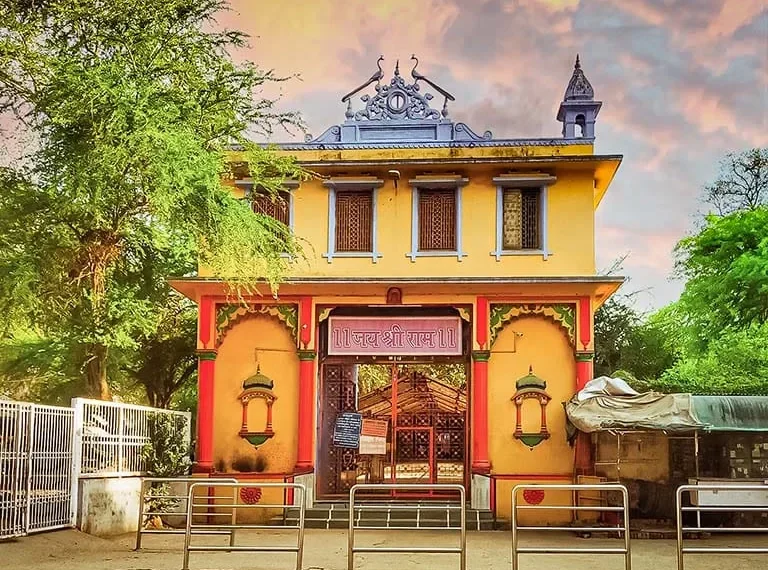In Varanasi, Uttar Pradesh, near Assi Ghat by the Ganga River, the Sankat Mochan Hanuman Temple is a sacred place where people worship Lord Hanuman, the loyal devotee of Lord Rama. This writing tells the temple’s story, its tales, its build, why it matters for worship, and what visitors need to know before visiting the temple.
History of Sankat Mochan Hanuman Temple
The Sankat Mochan Hanuman Temple was built in the 16th century by Goswami Tulsidas, the saint who wrote the Ramcharitmanas. Varanasi, tied to Lord Shiva and sacred tales in the Ramayana, is a holy city. They say Tulsidas founded the temple after Hanuman appeared to him in a vision, asking for a place to be worshipped as Rama’s servant. The name “Sankat Mochan” means “reliever of troubles,” showing Hanuman’s role in helping devotees. In Varanasi’s crowded lanes, priests and worshippers keep the temple going, making it a main spot for Hanuman worship. Since it was built, it has been a place where people come to seek Hanuman’s strength, holding its place in Varanasi’s heart.
Legends of Sankat Mochan Hanuman Temple
The temple is tied to stories of Hanuman and local talk. The main tale says Tulsidas, while praying by the Ganga, saw Hanuman in a vision. It is said that Lord Hanuman once appeared to him with a command to raise a temple as a mark of devotion for the service rendered to Lord Rama. Those who arrive with faith speak of Lord Hanuman’s mercy, whose strength and loyalty as vividly portrayed in the Ramayana remain an enduring light for his devotees. It is believed that his blessings flow freely here to those who seek him with devotion and humility.
According to age-old tradition, the idol worshipped at this shrine was placed by the saint Tulsidas, whose name holds a sacred place in India’s devotional history. It is widely held that the image enshrined here still holds the living presence of Lord Hanuman. Through the years, many have quietly shared how their prayers at this very place brought them a rare sense of calm or eased burdens that weighed heavily on their hearts.
Architecture of Sankat Mochan Hanuman Temple
The temple has a plain North Indian look. Made with stone and plaster, it’s a simple structure with a low dome and plain gates. The main shrine holds the idol of Hanuman, covered in orange paste, standing with a club and a picture of Rama in his heart. The idol’s strong face calls those who come to pray. The temple’s yard is open, with a few pillars and a tiled floor. The busy lanes around it give a holy feel, full of chants and steps. Inside, it has plain walls with small images of Rama and Sita, but keeps prayer first. Near the entrance, there is a quiet space where devotees often sit to listen to bhajans sung by the temple priests. This open spot offers a soothing environment, inviting visitors to pause and reflect. The temple itself carries a plain and sacred look, in keeping with the spiritual essence of Varanasi, a city where stories of Lord Rama and Hanuman are part of daily life.
Religious Significance
The temple is a spot to seek blessings and feel Hanuman’s presence. The darshan, with clear views of the idol, is a special way, joined by chants and bells. Daily aartis, at 5:00 AM and 7:30 PM, bring songs, bells, and incense, making a holy space. Festivals like Hanuman Jayanti, in March or April, and Ram Navami, in April, fill the temple with songs, dances, and offerings of laddoos and flowers. Tuesdays and Saturdays invite big crowds chanting the Hanuman Chalisa. Hanuman Jayanti is the biggest festival celebrating Hanuman’s birth with prayers and processions. Ram Navami honors Rama, with Hanuman’s devotees joining in worship.
Visiting Information for Sankat Mochan Hanuman Temple
How to Get There
The temple is in Varanasi, near Assi Ghat, 5 kilometers from Varanasi Junction.
By Air: Lal Bahadur Shastri Airport, about 25 kilometers from the temple, connects Varanasi with cities such as Delhi, Mumbai, and Lucknow. Visitors can reach the temple from the airport by taxi or auto-rickshaw in approximately 45 minutes.
By road: Varanasi lies close to 300 kilometers from Lucknow and approximately 120 kilometers from Allahabad, with the National Highway 19 as route.
Temple Hours: The temple welcomes visitors daily from 4:00 AM to 10:00 PM. Aartis are held twice each day, one early morning at 5:00 and in the evening at 7:30. Extra ceremonies also take place during major festivals like Hanuman Jayanti. It is best to confirm festival schedules with temple officials.
Best Time to Visit: From October to March, the weather is cool and comfortable, with temperatures typically between 15°C and 25°C, making it the perfect time to visit Varanasi. Festivals such as Hanuman Jayanti and Ram Navami fill the city with lively celebrations but also draw large crowds.
Rules for Visitors
Wear appropriate clothes: men need shirts, trousers, or dhotis; women should wear sarees or churidar with a dupatta. No shorts or sleeveless tops.
Take off shoes before going in. A storage spot is there, with a small fee.
No photos inside the Sanctum, outside photos need priest permission.
Offerings like laddoos, flowers, or sindoor are fine, talk to priests for special prayers.
No smoking, spitting, or alcohol.
Final Words
Sankat Mochan Hanuman Temple in Varanasi stands as an embodiment of Lord Hanuman’s shakti of unwavering devotion. Located in this ancient city, the temple offers visitors a chance to connect with India’s deep religious heritage making it a must visit temple when visiting Varanasi.











